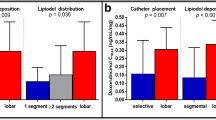Abstract
This study aimed to evaluate and compare the biodistribution properties of three transarterial Lipiodol-based therapeutic regimens in human hepatocellular carcinoma (HCC). In this prospective study with 13 patients randomly allocated to one of three study groups, each of the patients received transcatheter intra-arterial administration into a solitary HCC with one of three different Lipiodol-based formulations: Lipiodol-ethanol mixture (LEM; Group A), Lipiodol alone (Group B), and Lipiodol and gelatin pledgets (Group C). With the use of radioactive iodine-131-labeled Lipiodol, each group was assessed for (1) pattern of Lipiodol accumulation in the lungs within the first 2 weeks as evaluated by single-photon emission computed tomography and (2) decomposition of Lipiodol formulation within the first 2 weeks as evaluated by radioactivity detected in peripheral blood and urine. The degree of Lipiodol retention in the tumor within the first 4 weeks was evaluated with CT. No statistically significant difference in Lipiodol accumulation in the lungs was detected among the three groups. However, the peak accumulation in the lungs was delayed 3 days for Group A compared to Groups B and C. The degree of Lipiodol retention within the tumor in Group A was significantly greater than that in Groups B and C on day 14 (p = 0.014) and day 28 (p = 0.013). This study showed that LEM is associated with a greater embolic effect in intrahepatic HCC at 4 weeks, and a comparable degree of lung shunting and decomposition rates, compared with ethanol-free Lipiodol formulations.







Similar content being viewed by others
References
El-Serag HB, Mason AC (1999) Rising incidence of hepatocellular carcinoma in the United States. N Engl J Med 340:745–750
Taylor-Robinson SD, Foster GR, Arora S, et al. (1997) Increase in primary liver cancer in the UK, 1979–94. Lancet 350:1142–1143
Neuhaus P, Jonas S, Bechstein WO, et al. (1999) Liver transplantation for hepatocellular carcinoma. Transpl Proc 31:469–471
Moe E, Kaspa RT, Sheiner P, et al. (1998) Treatment of hepatocellular carcinoma associated with cirrhosis in the era of liver transplantation. Ann Int Med 129:643–653
Farmer DG, Rosove MH, Shaked A, et al. (1994) Current treatment modalities for hepatocellular carcinoma. Ann Surg 219:236–247
Strong RW (2000) Transplantation for liver and biliary cancer. Sem Surg Oncol 19:189–199
Hemming AW, Cattral MS, Reed AI, et al. (2001) Liver transplantation for hepatocellular carcinoma. Ann Surg 233:652–659
Yamamoto J, Okuda S, Shimada K, et al. (2001) Treatment strategy for small hepatocellular carcinoma: comparison of long-term results after percutaneous ethanol injection therapy and surgical resection. Hepatology 34:707–713
Livraghi T, Goldberg SN, Lazzaroni S, et al. (1999) Small hepatocellular carcinoma: treatment with radio-frequency ablation versus ethanol injection. Radiology 210:655–661
Lencioni RA, Allgaier HP, Cioni D, et al. (2003) Small hepatocellular carcinoma in cirrhosis: randomized comparison of radio-frequency thermal ablation versus percutaneous ethanol injection. Radiology 228:235–240
Llovet JM, Real MI, Montana X, et al. (2002) Arterial embolisation or chemoembolisation vs symptomatic treatment in patients with unresectable HCC: a randomised controlled trial. Lancet 359:1734–1739
Lo CM, Ngan H, Tso WK, et al. (2002) Randomized controlled trial of transarterial Lipiodol chemoembolization for unresectable HCC. Hepatology 35:1164–1171
Cammà C, Schepis F, Orlando A, et al. (2002) Transarterial chemoembolization for unresectable hepatocellular carcinoma: meta-analysis of randomized controlled trials. Radiology 224:47–54
Geschwind JFH, Ramsey DE, Douglas EAB, et al. (2003) Chemoembolization of hepatocellular carcinoma: results of a metaanalysis. Am J Clin Oncol 26:344–349
Iwai K, Maeda H, Konno T (1984) Use of oily contrast medium for selective drug targeting to tumor: enhanced therapeutic effect and X-ray image. Cancer Res 44:2115–2121
Nakakuma K, Tashiro S, Hiraoka T, et al. (1985) Hepatocellular carcinoma and metastatic cancer detected by iodized oil. Radiology 154:15–17
Matsui O, Kadoya M, Yoshikawa J, et al. (1993) Small hepatocellular carcinoma: treatment with subsegmental transcatheter arterial embolization. Radiology 188:79–83
Park JH, Han JK, Chung JW, et al. (1993) Superselective transcatheter arterial embolization with ethanol and iodized oil for hepatocellular carcinoma. J Vasc Interv Radiol 4:333–339
Ito K, Kusunoki H, Okamoto E, et al. (1994) Intra-arterial alcoholization of advanced hepatocellular carcinoma. Can Chemo Pharmacol 33(Suppl):S42–S47
Cheng Y, Kan Z, Chen C, et al. (2000) Efficacy and safety of preoperative lobar or segmental ablation via transarterial administration of ethiodol and ethanol mixture for treatment of hepatocellular carcinoma:clinical study. World J Surg 24:844–850
Kan Z, Ivancev K, Lunderquist A (1994) Peribiliary plexa-important pathways for shunting of iodized oil and silicon rubber solution from the hepatic artery to the portal vein: an experimental study in rats. Invest Radiol 29:671–676
Kan Z, Wallace S (1997) Transcatheter liver lobar ablation: an experimental trial in an animal model. Eur Radiol 7:1071–1075
Yu SCH, Chan CTP (2006) Transarterial ethanol ablation of cirrhotic liver with Lipiodol-ethanol mixture: safety and efficacy study in rats. Invest Radiol 41(8):609–617
Madsen MT, Park CH, Thakur ML (1988) Dosimetry of iodine-131 ethiodol in the treatment of hepatoma. J Nucl Med 29:1038–1044
Lau WY, Leung WT, Ho SKW, et al. (1999) Adjuvant intra-arterial iodine-131 labeled Lipiodol for resectable hepatocellular carcinoma:a prospective randomized trial. Lancet 353:797–801
Goldstein H (1995) Multilevel statistical models. In: Goldstein H (ed) Kendalls library of statistics 3. Edward Arnold, London, p 874
Ueno K, Miyazono N, Inoue H, et al. (2000) Transcatheter arterial chemoembolization therapy using iodized oil for patients with unresectable hepatocellular carcinoma:evaluation of three kinds of regimens and analysis of prognostic factors. Cancer 88:1574–1581
Ohishi H, Uchida H, Yoshimura H, et al. (1985) Hepatocellular carcinoma detected by iodized oil:use of anticancer agents. Radiology 154:25–29
Vogl TJ, Trapp M, Schroeder H, et al. (2000) Transarterial Chemoembolization for hepatocellular carcinoma: volumetric and morphologic CT criteria for assessment of prognosis and therapeutic success—results from a liver transplantation center. Radiology 214:349–357
Author information
Authors and Affiliations
Corresponding author
Additional information
This paper was presented at the 2007 CIRSE Congress.
Rights and permissions
About this article
Cite this article
Yu, S.C.H., Leung, T.W.T., Lau, W.Y. et al. A Comparison of Three Transarterial Lipiodol-Based Formulations for Hepatocellular Carcinoma: In Vivo Biodistribution Study in Humans. Cardiovasc Intervent Radiol 31, 289–298 (2008). https://doi.org/10.1007/s00270-007-9173-8
Received:
Accepted:
Published:
Issue Date:
DOI: https://doi.org/10.1007/s00270-007-9173-8




